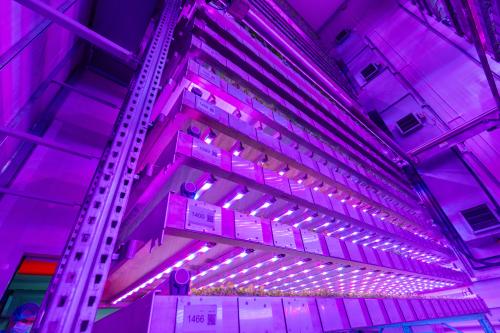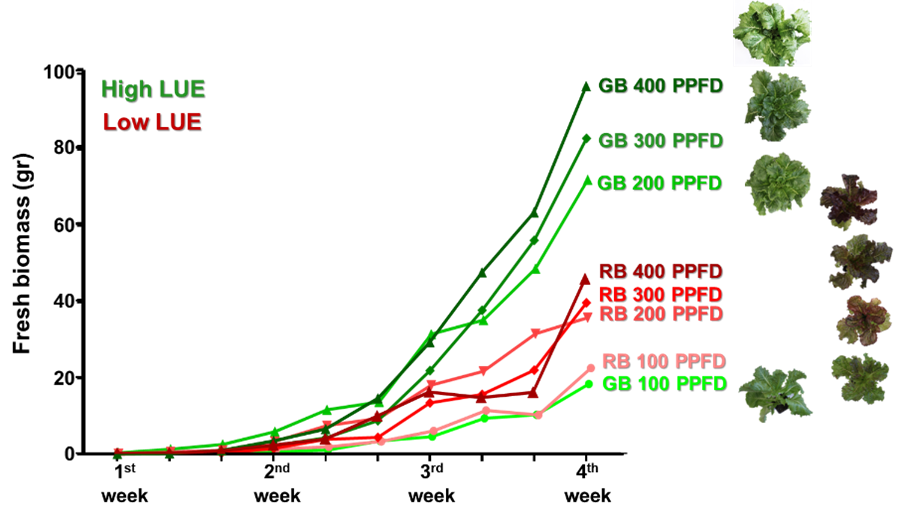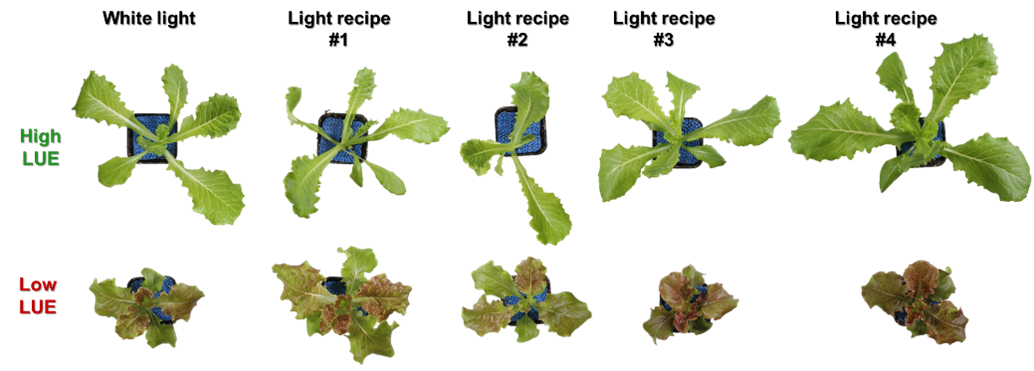Fluctuating environmental conditions severely impact Scottish crop production affecting crop yields, nutritional quality and food security. Growth in indoor environments such as vertical farms (VF) offers opportunities to extend food security by providing year-round production in precise, pest-free, optimised environments for year-round production of high-quality crops irrespective of external conditions. However, VFs require significant energy for lighting and the maintenance of optimised temperature and humidity limiting their application.
To address this problem, we have conducted research to understand how to optimise lighting to maximise crop productivity whilst minimising energy inputs addressing an immediate need to reduce costs. We are additionally seeking to identify light use efficiency markers to accelerate the breeding of cultivars specifically for indoor production.
This work provides the industry with a toolkit to optimise productivity and paves the way for longer term efficiency gains by developing bespoke cultivars for indoor environments.

Stage
Directory of Expertise
Purpose
Currently, the economics of vertical farming limit crop diversity to high-value crops or fast-maturing products such as salad leaves, with only 50% of controlled environment farms operating profitably (Global CEA Census Report, 2020). A key limiting factor is the energy requirement to generate the light plants need for photosynthesis, the biological process that converts light and carbon dioxide into biomass and oxygen. Therefore, any effort to optimise light use efficiency will impact profitability.
Advanced lighting technologies have resulted in large improvements in LED energy efficiency. This increase in efficiency has massively enhanced the feasibility of indoor agriculture, however, further efficiency increases are slowing significantly. Therefore, other areas of efficiency improvement need to be exploited if further advances are to be made.
Our experimental approach leverages natural genetic variation to select lettuce varieties with high light use efficiency and, eventually, will contribute to breeding new varieties that are better able to convert light energy into crop yield. It is estimated that up to 3000 different lettuce varieties are stored around the world, yet, only a few varieties have been evaluated and are being grown in VF. These varieties were selected for their wide use in outdoor agriculture, where environmental conditions and resources available, especially light, are drastically different.
In this study, we evaluated some of the most used lettuce varieties in VF to determine their photosynthetic performance, in addition to identifying combinations of light intensity and quality that improve yield and nutritional profile. Moreover, RESAS support has underpinned a successful bid for funding to extend the work to identify genes essential for improved light use efficiency. This work paves the way for breeding efficient varieties specifically for indoor farming environments.
Results
Green and red lettuce varieties were evaluated growing under multiple light intensity regimes, from suboptimal light to more than twice the light intensity normally used for this crop in VF. We detected wide photosynthetic differences between varieties and identified some with high light use efficiency and others with low light use efficiency (Figure 1).

Figure 1. Growth in green and red lettuce varieties under different light intensities (photosynthetic photon flux density, PPFD). The x-axis indicates time and the y-axis indicates biomass. The green variety was able to efficiently use higher light intensities for biomass accumulation in contrast to the red variety.
We tested high- and low- light use efficiency lettuce varieties under different light recipes, carefully designed to use the optimal light intensity and selected combinations of light wavelengths (green, blue, red and far-red). This allowed us to identify tailored light recipes for each variety that optimise growth and yield (Figure 2), and product quality (Figure 3). Different coloured LEDs have different energy requirements therefore by optimising LED use we are able to link biomass accumulation to input costs.

Figure 2. Green and red lettuce grown under different light quality by combining green, blue, red and far-red wavelengths in different recipes. Light intensity was matched in all treatments.
By fine-tuning the light recipe, we directly influenced the physiological and metabolic processes within the crop, which ultimately led to the identification of light recipes that improved product quality, such as enhanced sugar profiles (Figure 3), as well as improved yield (Figure 2).

Figure 3. Sugar profiles of green and red lettuce varieties grown under different light recipes
To identify genes associated with light use efficiency, we have taken advantage of a closely related cross between a Romaine and an Iceberg lettuce. Closely related crosses help to study specific traits such as light use efficiency more accurately. Using photosynthetic gas exchange and chlorophyll fluorescence measurements we have derived key parameters associated with the different processes involved in photosynthesis (photochemical and biochemical processes). This has highlighted significant diversity in the offspring of the cross and we are presently determining the genetic make-up of all of the Romaine x Iceberg generations. By combining the genetic with the physiological information, we will be able to identify favourable markers and genetic variants providing the tools required to accelerate breeding of VF adapted cultivars.
Benefits
This research integrates genetic screening with precision lighting technology to optimise efficiency in vertical farming by developing improved crop management and working towards the development of VF adapted crop varieties. By identifying lettuce varieties that use light more efficiently and developing tailored LED light recipes that represent the optimal selection of wavelengths for growth, we can significantly boost plant growth, yield, and nutritional quality. This approach also enhances energy efficiency by reducing unnecessary light waste, which is an important step towards sustainable agriculture. Furthermore, this accumulated experience and knowledge can be used for other VF crops.
Acknowledgements:
Work was funded by the Rural and Environment Science and Analytical Services Division (RESAS) Strategic Research Programme 2022-2027 Project B1-3 The impact of novel crops and farming practices on the Scottish agricultural landscape and the Biotechnology and Biological Sciences Research Council (BBSRC) grant number BB/Z514731/1
Lead image: Intelligent Growth Solutions vertical farm based on the James Hutton Institute campus at Invergowrie. Photo credit: Intelligent Growth Solutions.
Project Partners
University of Reading
Intelligent Growth Solutions Ltd
Tozer Seeds Ltd
Crocus Labs GmbH